Shep Hyken's Blog, page 82
July 2, 2021
Guest Post: Here Are The Do’s & Don’ts of Social Media Customer Service
This week we feature an article by Devin Pickell, Growth Marketer at Nextiva. He writes about the do’s and don’ts of social media customer service.
We already know more brands are using social media as a customer service channel for answering FAQs, customer complaints, and general support questions.
While social media is a great channel for facilitating customer inquiries, there is a right and a wrong way to use the channel. It’s time to review the do’s and don’ts of social media customer service.
4 Do’s of Social Media Customer Service Nail down a workflow for handling customer questionsBefore getting into the nitty-gritty of actual customer service, you need to figure out a workflow for handling inquiries. That takes answering some of the questions below:
What is the volume of inquiries in your social media inboxes? Does your social media specialist have the autonomy to answer FAQs, or will there be a different point person? How will your brand standards for customer service work into social media?
Layout a customer service workflow before implementing it. You can use a variety of project management tools for keeping this workflow organized in a single space.
Determine your most frequently asked questionsAre you finding any patterns in questions or concerns stated over social media? Compile the most frequently asked questions in a shared document, determine the best possible answers, and distribute the document to your customer service team.
This document will act as a single source of truth your team can reference. It also ensures the service they provide is on-brand and doesn’t deviate much from what your customers expect. Finally, these FAQs can be automated in the next section.
Use automation when necessarySome social media platforms like Twitter and Facebook allow brands to automate customer service through a button-based chatbot. See the example below from Macy’s:
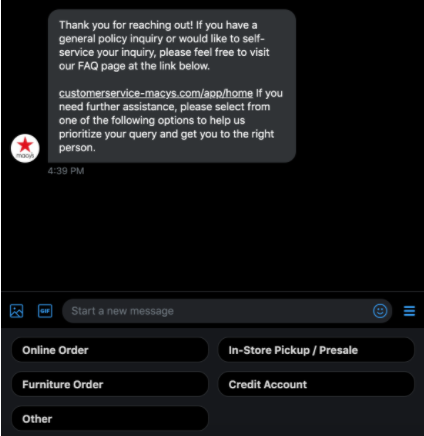
Chatbots like these are a great way to answer simple questions and offer customers a self-service option. Based on data from Harvard Business Review, we know that 8 in 10 consumers are open to resolving issues themselves.
But these chatbots, like any chatbots, should still be able to escalate to a human agent in case a more complex question arises or the chatbot faces a technical error. You can even leave a number to your inbound call center in case they require phone support.
Provide speedy supportResponse time is everything when it comes to social media customer service, especially on platforms like Twitter where a users’ content feed speeds by them.
According to the Sprout Social Index report, 40% of consumers expect brands to respond within the first hour of reaching out on social media, while 79% expect a response in the first 24 hours.
Failing to resolve complaints quickly will make a customer think twice about doing business with your brand, due to fractured trust.
4 Don’ts of Social Media Customer Service Don’t ignore customer complaintsA cardinal sin of social media customer service is ignoring your customer complaints. It’s one thing to not interact with spammy accounts, it’s another thing to completely avoid confrontation on social media. In fact, 88% of consumers said they were less likely to buy from a brand in the future if their complaints went ignored on social media.
Get in front of complaints. You don’t need to answer them in a public forum setting. Instead, you can ask the customer to DM you more details about the issue so they can get it resolved quickly.
Don’t engage with spam accountsSpam accounts, bot accounts, and what are referred to as “trolls” are all over social media these days. In fact, an estimated half of all Twitter accounts aren’t people – they’re bots, according to a CNBC study.
These accounts exist to give you a hard time, so it’s best not to engage with them and fill up your customer service queue.
Be on the lookout for accounts that look fake, have little-to-no engagement, and are overly aggressive on social media. When in doubt, ask for an order number to cross-reference their account and see if they’re an actual customer.
Don’t get defensive or upsetIt can be easy to get caught up in a customer service interaction that is frustrating you personally. But don’t budge. Acting outside your brand standards for customer service could hurt your brand and may even get you in trouble.
Be professional, take a deep breath, and keep it cool. One way to do this is by empathizing with the customer on the other side of the interaction. They could be facing issues with your return policy, missing an order, or even going through something personal that you wouldn’t be aware of over social media.
Taking the high road and prioritizing their problem is the key to better customer service.
Don’t promise service you can’t provideFinally, don’t promise customer service you know you can’t provide. For example, don’t claim you offer 24/7 support if you don’t have a chatbot or a distributed team able to take support requests outside of your working hours.
We all want to provide the best service possible, but missing the mark on your promises is yet another way to hurt your brand. It fractures your customers’ trust the next time they need an issue resolved.
If your main brand social media account is facing too many support requests, try creating an account solely for customer service. Brands like HubSpot, Uber, Coinbase employ this tactic successfully.
Devin Pickell is a Growth Marketer at Nextiva. He combines his skills in content marketing, SEO, data analysis, and marketing strategy to meet customers at the right moment in their journey.
 For more articles from Shep Hyken and his guest contributors go to customerserviceblog.com.
For more articles from Shep Hyken and his guest contributors go to customerserviceblog.com.
Read Shep’s latest Forbes article: Authenticity Is A Driver Of Trust: The Next Competitive Strategy
The post Guest Post: Here Are The Do’s & Don’ts of Social Media Customer Service appeared first on Shep Hyken.
June 30, 2021
How to Handle Difficult Customers
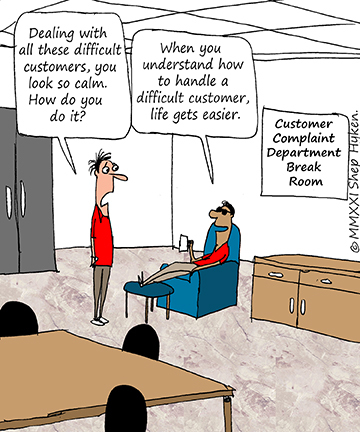 Not long ago I covered six ways to handle angry customers. Often an angry customer and a difficult customer are the same. But that’s not always true. Sometimes difficult customers aren’t angry. They are just tough and demanding. That said, the techniques I cover in both of these posts can work, with a little tweak or variation depending on the situation. So, after you read this, I urge you to go back and read the original article. This is a follow-up with another half dozen techniques to manage angry and/or difficult customers.
Not long ago I covered six ways to handle angry customers. Often an angry customer and a difficult customer are the same. But that’s not always true. Sometimes difficult customers aren’t angry. They are just tough and demanding. That said, the techniques I cover in both of these posts can work, with a little tweak or variation depending on the situation. So, after you read this, I urge you to go back and read the original article. This is a follow-up with another half dozen techniques to manage angry and/or difficult customers.
So, here are six ways to handle difficult customers:
Avoid acting indifferent toward your customer. Customers want your attention, and they want to feel as if the relationship you have with them is important. Indifference is apathy. That will never make a customer happy.Ask the right questions. These are the appropriate questions that give you the answers to understand the situation. But, be careful about interrupting with questions. That can frustrate the customer. There may be a time you need to interrupt, but just go about it the right way. Cutting the customer off could end up escalating the anger or problem, when it’s your intention to do the opposite.Empathize! This has become a very popular word. Customers want you to empathize and understand their situation. The old expression about putting yourself in the customer’s shoes comes to mind. Saying something like, “I know how you feel. I would feel the same way if that happened to me,” could help customers know you’re on their side.Don’t tell the customer he or she is wrong. This isn’t about who is right or who is wrong. This is about getting the customer to say, “Thanks for taking great care of me.” You’re not going to get there if you’re accusing the customer of being wrong. Remember one of my favorite sayings: The customer is not always right! But when they are wrong, let them be wrong with dignity and respect.Don’t blame others inside your company. Never make anyone in your organization look bad. When a problem comes your way, you own it, regardless of who is at fault.Focus on a positive outcome. Instead of focusing on what you can’t do, focus on what you can do. Customers want to know they are talking to someone who can solve their problems.So, there are six more tips on how to handle difficult and angry customers. In any given situation, one or more of these tactics may come in handy. Remember, you’re trying to get the customer to come back. As you interact with them, ask yourself, “Is what I’m doing right now going to make my customer come back the next time they need what we sell?”
Shep Hyken is a customer service expert, keynote speaker, and New York Times, bestselling business author. For information on The Customer Focus customer service training programs, go to www.thecustomerfocus.com. Follow on Twitter: @Hyken
customer service training programs, go to www.thecustomerfocus.com. Follow on Twitter: @Hyken
(Copyright © MMXXI, Shep Hyken)
The post How to Handle Difficult Customers appeared first on Shep Hyken.
June 29, 2021
Amazing Business Radio: Shirley Macbeth
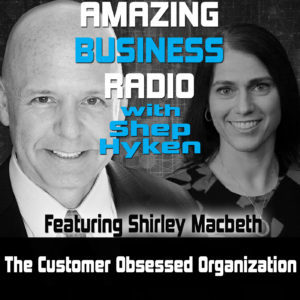 The Customer Obsessed Organization
The Customer Obsessed OrganizationHow to Lead with the Customer First
Shep Hyken interviews Shirley Macbeth, Chief Marketing Officer at Forrester, responsible for elevating the company’s thought leadership profile and generating demand for its portfolio of research, consulting, and events. They discuss how customer-obsessed organizations must put their customers at the center of their leadership, strategy, and operations.






 Top Takeaways:Many companies think that they are customer-obsessed while unaware of the customer-focused gaps within their organization. These gaps can be felt by the customers through their digital channels, interactions with people, and a variety of things in their organization.Gaps in being a customer-obsessed organization happen when companies do not deliver their brand promise.The brand promise falls into three categories:‘Unlike the others’ – Being different, quirky, or unusual.‘At your service’ – Differentiating the experience through amazing customer service.‘On your side, by your side’ – Being the customer’s advocate.A customer-obsessed organization listens to their clients and takes actions based on the information that they receive.In 2017, it would have taken 17 interactions with a brand to close a typical B2B transaction. Now, it takes 27 with 4 or more people involved before customers can make a buying decision.Throughout the pandemic, the racial tensions that we are in, and the environmental issues that we are facing, customers are taking a closer look at the brands that they want to trust and do business with.What happens inside an organization is felt on the outside by the customers.Many companies underestimate the importance of how employees feel about how service is delivered to their customers.Alignment in business is knowing who your customer is, how you want them to feel, and shaping your product around customer obsession.Aligned organizations have 19% faster growth and 15% higher profitability.Quotes:
Top Takeaways:Many companies think that they are customer-obsessed while unaware of the customer-focused gaps within their organization. These gaps can be felt by the customers through their digital channels, interactions with people, and a variety of things in their organization.Gaps in being a customer-obsessed organization happen when companies do not deliver their brand promise.The brand promise falls into three categories:‘Unlike the others’ – Being different, quirky, or unusual.‘At your service’ – Differentiating the experience through amazing customer service.‘On your side, by your side’ – Being the customer’s advocate.A customer-obsessed organization listens to their clients and takes actions based on the information that they receive.In 2017, it would have taken 17 interactions with a brand to close a typical B2B transaction. Now, it takes 27 with 4 or more people involved before customers can make a buying decision.Throughout the pandemic, the racial tensions that we are in, and the environmental issues that we are facing, customers are taking a closer look at the brands that they want to trust and do business with.What happens inside an organization is felt on the outside by the customers.Many companies underestimate the importance of how employees feel about how service is delivered to their customers.Alignment in business is knowing who your customer is, how you want them to feel, and shaping your product around customer obsession.Aligned organizations have 19% faster growth and 15% higher profitability.Quotes:“Lead with the customer first. Keep the customer in mind with every decision that your company makes.”
“Customer obsession must involve the leaders of the company, its processes, its strategy, its marketing, and the employees.”
“When done right, customer obsession can generate twice the profitability, revenue, and employee retention.”
“Customers now expect brands to take a stance on the issues that they care about.”
“Every company has a product or a solution, but its people are the most important part of the brand.”
About:Shirley Macbeth is the Chief Marketing Officer at Forrester. Macbeth has 25+ years of experience as a marketing executive with a proven track record in increasing revenues and building brand awareness for global B2B companies.
Shep Hyken is a customer service and experience expert, New York Times bestselling author, award-winning keynote speaker, and your host of Amazing Business Radio.
This episode of Amazing Business Radio with Shep Hyken answers the following questions … and more:
What is customer obsession?How do you create a customer-obsessed organization?What is the difference between customer service and customer obsession?How has the pandemic changed customer expectations and interactions?Why is delivering your brand promise important?The post Amazing Business Radio: Shirley Macbeth appeared first on Shep Hyken.
June 28, 2021
5 Top Customer Service Articles of the Week 6-28-2021
Each week I read many customer service and customer experience articles from various resources. Here are my top five picks from last week. I have added my comment about each article and would like to hear what you think too.
America’s Best Customer Service Companies by Newsweek(Newsweek) Newsweek has again partnered with respected global data research firm Statista to identify the stores that consistently provide the Best Customer Service 2021.
My Comment: We start off this week with Newsweek’s list of America’s BEST customer service companies. Be sure to check out the drop-down box that allows for the data to be broken up into different categories. It’s interesting how the scores determine the ranking. So, what to do with this list? Consider listing the companies/brands that closely resemble your organization. Then do a Google search for articles about their success. You just might find an idea or two that you can make your own.
Can Disney’s Customer Service Model Work in Government? by Carl Smith(Governing) In the public sector, customer service can easily devolve to “our way or the highway.” The head of the Arlington, Texas, planning department is transforming its service culture into a place where your “dream comes true.”
My Comment: How would you like the customer service at a government agency to be as good as going to a Disney theme park? Imagine walking into a government office and the employee greets you with, “How can we make your dream come true today?” Well, that’s exactly what you might experience when you interact with the employees in Arlington, TX.
Are You Using these Customer Experience Power Phrases? by Joseph Michelli, Ph.D.(Linkedin Pulse) Last month, Joseph Michelli shared “5 Things Service Professionals Should NEVER Say.”
This month, he presents the flipside, 5 Things Service Professionals Should ALWAYS Say.
My Comment: Joseph Michelli is back this week, and this time with a list of five “power phrases” your customers love to hear. And, while you are there, be sure to click on the link that takes you to the article he shared last month, which is a list of the five things you should never say to a customer.
Communicating CX: 12 Tips for Talking About Customer Experience by Jeannie Walters, CCXP(Linkedin Pulse) The foundational work of defining CX at your organization, through a CX Mission Statement and CX Success Statement, is so critically important to accomplishing real change and delivering on real outcomes through customer experience.
My Comment: We encourage our clients to have a cadence of ongoing discussions around customer service and CX. Some of our clients do this weekly. A few do it daily. It’s important to have conversations like these to keep service and experience front of mind. Here is a list of twelve CX conversation-starters to get your team talking.
10 Ways to Gain the Loyalty of Return Visitors by Lauren Voges(American Alliance of Museums) Here are ten ways museums and attractions can continue to attract return visitors, including local staycationers, daytrippers, and audiences outside the usual target market.
My Comment: Do you want your customers to come back? Of course, you do! Something that intrigued me about this article was the title. It’s obvious the author recognizes there is a difference between repeat customers (She refers to them as return visitors.) and loyalty. Here is a list that at worst, will help motivate your customers to come back. At best, they go from returning customers to loyal customers.
BONUSES10 Ways to Improve CX by Reducing Customer Complexity by Ricardo Saltz Gulko(MyCustomer) We are experiencing a reset as a result of the pandemic, and those companies that continue to deliver overcomplicated solutions are living on borrowed time. With that in mind, here’s how to use experience design to create better CX through reduced complexity.
My Comment: There were so many great articles this week, so I couldn’t stop with just five. Here is an excellent one by Ricardo Saltz Gulko about reducing customer complexity. Another way of putting it, is to reduce friction and be more convenient. Here’s another list that includes ten suggestions on creating a better CX by paying attention to the experience design.
25 Customer Experience Blogs to Add to Your Weekly Reading List by Jessica Wise(HelpSquad) If you’re looking to improve your relationship with your customers through the power of reading, look no further. Here are 25 customer experience blogs to add to your weekly reading list.
My Comment: Let’s round out the TOP FIVE (Plus) list of articles with a post from HelpSquad, which includes the 25 customer service blogs to subscribe to and read. I’m honored to be on the list (Thank you HelpSqud!) that includes some amazing experts. Here you will find more experts to learn from.
Shep Hyken[image error] is a customer service expert, professional speaker, and New York Times bestselling business author. Go to The Customer Focus to learn more about our customer service training programs. Follow on Twitter: @Hyken
to learn more about our customer service training programs. Follow on Twitter: @Hyken
The post 5 Top Customer Service Articles of the Week 6-28-2021 appeared first on Shep Hyken.
June 25, 2021
Guest Post: Leaders Need to Show, Not Just Say
This week we feature an article by Annette Franz, CCXP, the founder and CEO of CX Journey Inc. She writes about how leaders can lead by example and model the change that they wish to see from their employees.
How do leaders drive (lasting) change?
Back in 2019, I enjoyed spending a few days in Vegas, speaking and networking at Fiserv’s annual client Forum. The keynote on the second day of the event was Troy Aikman, who was interviewed by Fiserv’s CEO Jeff Yabuki about sports, of course, as well as about leadership and business.
One of the stories that Troy shared resonated with me because it’s exactly the kind of thing that I talk about when it comes to driving lasting change: leaders can’t just talk the talk; they must walk the walk.
The story goes something like this.
Troy is a sharp-dressed man; when it comes to work/business, he is always dressed in a suit. After he bought his first car dealership, he walked in and noticed that all of the sales guys were dressed casual, in polo shirts and slacks. He wanted them to dress nicer, but he didn’t want to come into his new business and be a hard nose right away. So, he didn’t say anything. Instead, he just showed up at the dealership every day in a suit. By the end of the first week, a couple of the guys had upgraded their attire, and by the end of the second week, all of them were dressed in suits. And he never said a word!
It’s a great reminder that you can drive change – lasting change – when you do a few simple, yet often forgotten, things. Troy didn’t talk about any conversations he had with the staff after the two weeks, but I can only imagine he applauded their actions.
To drive lasting change…
Communicate the change, using a variety of vehicles and media. Share the change vision. Tell the change story. Let employees know what is changing, why it’s changing, how it will impact them and what they do (differently) on a daily basis, and how they will be involved. If no one knows what the change is or why it’s taking place, then they’ll ignore it; they certainly don’t want to be a part of it. Involve employees in the change process rather than forcing change on them. If they’re involved, the solutions may be richer because they have other perspectives and experiences that the decision-making leader may not have. Better yet, present them (spoke or unspoken, as was the case with Troy) with a problem or a situation, and let them come to the conclusion themselves. If they believe it was their own idea, it’ll stick; they’ll own it. It’s important that executives lead by example and model the change that they wish to see from their employees; if they don’t live the change, why should employees?! If your CEO doesn’t demonstrate commitment to the transformation by being the role model for how to deliver a great experience, it won’t happen. If she doesn’t live the core values, why should you? Actions always speak louder than words. Recognize the right behaviors and reinforce with incentives, promotions, metrics, and more. Reinforcing the behaviors, actions, and changes that you want to see is more powerful than talking about them, especially when combined with modeling them.Yes, change is hard. But it’s not impossible. These four things are important and work together. Just remember this: leaders can’t expect to see change happen if all they do is talk about the changes but don’t do things differently themselves. Case in point: if you’re talking about transforming your culture to one that is customer-centric, yet you continue to push staff to make their quarterly numbers and reinforce behaviors that speak to a focus on growth at all cost – sans focusing on the customer experience – then you’re not walking the walk.
Talk is cheap.
If you cannot prove it by your action(s), you do not mean it. -Murad S. Shah
Annette Franz, CCXP is the founder and CEO of CX Journey Inc., a leading consulting service for the major voice of the customer (VOC) platforms, helping clients in a variety of industries. She is an internationally recognized customer experience thought leader, coach, keynote speaker, and author of Customer Understanding: Three Ways to Put the “Customer” in Customer Experience (and at the Heart of Your Business).
 For more articles from Shep Hyken and his guest contributors go to customerserviceblog.com.
For more articles from Shep Hyken and his guest contributors go to customerserviceblog.com.
Read Shep’s latest Forbes article: Authenticity Is A Driver Of Trust: The Next Competitive Strategy
The post Guest Post: Leaders Need to Show, Not Just Say appeared first on Shep Hyken.
June 23, 2021
Companies’ Responses to COVID Provide Insights into Handling a Crisis
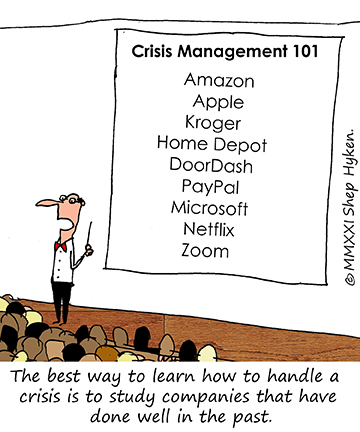 One of our readers asked me the following question: What is your advice for a company that is struggling during COVID-19?
One of our readers asked me the following question: What is your advice for a company that is struggling during COVID-19?
I know, we’re all tired of hearing about COVID-19 and the pandemic. However, there is light at the end of this very dark tunnel. We are seeing business in most industries returning to pre-pandemic levels. Still, some companies are still struggling. While some industries and companies flourished throughout the last year, many were forced to a level of flexibility that included major changes, just to barely survive and keep their doors open.
With that said, the answer I’m about to give applies not only to the last year and COVID-19, but also any time a business experiences negative national and world events, including economic downturns, terrorism, and yes, even global pandemics.
During tough times of any type, certain businesses struggle. The first reaction of many is to tighten expenses and reduce employees. Some go out of business. Then there are certain industries that may not be impacted. For example, during the pandemic, grocery stores flourished. Certain online retailers, like Amazon, had a banner year. And, there are companies that you think would have been impacted, but somehow they did well – and continue to do so.
So, consider all of that as I share an answer to the original question, which was advice for businesses struggling during COVID-19.
Start by getting a team together to strategize and share ideas. The conversation should begin with a discussion about the companies you believe had success throughout the pandemic. Again, this could be any major downturn in business due to outside and unforeseen circumstances. What did they do, if anything, that was different than they had done before the pandemic? What do you like – or not like – about the changes they made?
Then determine if any of these changes can work for your company. It doesn’t have to be exactly the same. Let this list serve as a catalyst to jumpstart creativity to come up with a list of ideas that might work for you. Then once you’ve created this list, don’t just look at it. Work it! Make it happen. The adoption of ideas from the success of others outside of your industry can make you more competitive inside your own industry.
This is a very short answer to a very big question. And, it’s not the only answer. So if you have another answer, we would all love to hear from you. Feel free to share!
Shep Hyken is a customer service expert, keynote speaker, and New York Times, bestselling business author. For information on The Customer Focus customer service training programs, go to www.thecustomerfocus.com. Follow on Twitter: @Hyken
customer service training programs, go to www.thecustomerfocus.com. Follow on Twitter: @Hyken
(Copyright © MMXXI, Shep Hyken)
The post Companies’ Responses to COVID Provide Insights into Handling a Crisis appeared first on Shep Hyken.
June 22, 2021
Amazing Business Radio: Paula Courtney
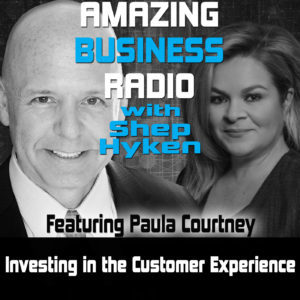 Investing in the Customer Experience
Investing in the Customer ExperienceLooking at Business through the Eyes of the Customer
Shep Hyken interviews Paula Courtney, President of the Verde Group. They discuss how businesses should invest in delivering a WOW customer experience.






 Top Takeaways:Even if you are in a B2B industry, decision-makers are still likely to compare you to their best experiences as a consumer.Digital transformation is more than just implementing technology. It is rethinking your business process to make it easier for customers to do business with you.Delivering a WOW customer experience can result in a 12-58% in the customer’s repurchase intent.Hassle-free customer support is the number one element that increases repurchase intent. This is followed by frictionless experience from start to finish and worry-free returns.To create a WOW customer experience, businesses do not need to do anything extraordinary. It is about delivering the basics consistently.The last best experience that your customers had with any business, in any industry, is what your customers will always compare you to.Quotes:
Top Takeaways:Even if you are in a B2B industry, decision-makers are still likely to compare you to their best experiences as a consumer.Digital transformation is more than just implementing technology. It is rethinking your business process to make it easier for customers to do business with you.Delivering a WOW customer experience can result in a 12-58% in the customer’s repurchase intent.Hassle-free customer support is the number one element that increases repurchase intent. This is followed by frictionless experience from start to finish and worry-free returns.To create a WOW customer experience, businesses do not need to do anything extraordinary. It is about delivering the basics consistently.The last best experience that your customers had with any business, in any industry, is what your customers will always compare you to.Quotes:“An attitude is a cognitive expression of an experience. By the time companies can measure attitude, they are already looking at the rearview mirror, unable to change the experience.”
“To get the attention of the C-suite about service improvement initiatives, you need to speak their language, Return on Investments.”
“Digital transformation is the integration of digital technology in all areas of the business.”
“Technology can force organizations to think differently about how they can serve their customers.”
“Put your business processes in the eyes of the customer before looking at it through the eyes of your bottom line.”
About:Paula Courtney is the President of the Verde Group. She leads the development of new research methods for helping companies quantify the financial impact of their customer experience.
Shep Hyken is a customer service and experience expert, New York Times bestselling author, award-winning keynote speaker, and your host of Amazing Business Radio.
The post Amazing Business Radio: Paula Courtney appeared first on Shep Hyken.
June 21, 2021
5 Top Customer Service Articles of the Week 6-21-2021
Each week I read many customer service and customer experience articles from various resources. Here are my top five picks from last week. I have added my comment about each article and would like to hear what you think too.
Do Your Rewards Rock? These 6 Rules Will Tell by Wise Marketer Staff
(The Wise Marketer) Too many reward programs solely focus on the points, rather than on the rewards their points or miles make possible. And without rockin’ rewards, the points are without meaning. Do your rewards hit the “must-have” mark that turns casual customers into brand fans?
My Comment: Reward programs are a great way to drive repeat business. If you have one, it may or may not be effective. This article may give you some insights as to why. There are plenty of great ideas. If you want to ROCK your loyalty program (if you have one), you’ll enjoy this article.
Is Simpler Better For Rewards Programs? by Tom Ryan
(RetailWire) Non-tiered customer loyalty programs were found to increase customer value by almost 30 percent over a five-year time period. Of the program’s total lift or effectiveness, more than 80 percent related to reduced attrition, while less than 20 percent was tied to increased frequency.
My Comment: As long as we’re on the topic of rewards programs, let’s look at a great article from RetailWire about going for a simpler program, the “non-tiered customer loyalty” program. First, I disagree that these programs create true loyalty. They create repeat business. Nothing wrong with that! Even though I consider them to be more about marketing, if they drive repeat business, that can turn into loyalty. I like RetailWire’s articles because they have numerous experts commenting on the topic.
10 Ways to Be More Human in the Age of AI by Terkel
(CIO Insight) What is one way that brands can be more human in the age of artificial intelligence (AI)? To help brands market themselves in the age of AI, CIO Insight asked business owners and marketing managers this question for their best advice. From creating genuine connections to personalizing your customer service, there are several suggestions that may help you reach more customers for the next quarter.
My Comment: I’ve said it before, you can’t automate a relationship. Here are ten experts weighing in with their tips and ideas on how to humanize the digital experience. Artificial Intelligence (AI) is getting better and better. The danger is that an automated experience can commoditize the company. Often, it’s the human and emotional connections that drive repeat business and loyalty.
Customer Service is a Gold Mine for Employee Experience Ideas by Russel Lolacher
(Russel Lolacher) What if we cared about our employees as much (or more) as we do about our customers? For inspiring employee experience ideas, a great place to look is what you’re probably already doing for the customer experience.
My Comment: Here’s another one of my favorite sayings: What’s happening on the inside of the organization is felt by the customer on the outside. The idea behind this article is to treat employees the way customers should be treated. The author takes traditional customer service ideas and flips them to be employee service ideas.
2021 and Beyond Loyalty Strategy by Retail TouchPoints
(Retail TouchPoints) You rely on your loyal customers. So, how can you develop a loyalty strategy that sets your brand apart and actually creates more loyalty? The key is to build relationships and make returning customers feel special. With the right loyalty strategy, 2021 could be your brand’s year to shine.
My Comment: It seems my favorite articles this week were focused on customer loyalty. This is actually a small report with three pretty simple, yet powerful ideas. I’m especially drawn to the third idea, which is about a personalized experience. That includes recognizing the customer, customizing their experience, and more. You’ll have to download the report and give them their email address. If you don’t like what the company sends you, just unsubscribe.
Shep Hyken[image error] is a customer service expert, professional speaker, and New York Times bestselling business author. Go to The Customer Focus to learn more about our customer service training programs. Follow on Twitter: @Hyken
to learn more about our customer service training programs. Follow on Twitter: @Hyken
The post 5 Top Customer Service Articles of the Week 6-21-2021 appeared first on Shep Hyken.
June 18, 2021
Guest Post: How to Care About Your Customers
This week we feature an article by Rupert Jones, a passionate speaker and an Independent Financial Advisor. He writes about the 7 customer service elements that ensure your shoppers stay happy and included.
Businesses wouldn’t be anything without their customers’ continuous support. Therefore, it’s essential to show your loyal buyers how integral they are to your success. Otherwise, they may feel unappreciated and start to seek out other alternatives. To ensure your shoppers stay happy and included, care for them by prioritizing these 7 customer service elements.
Hire and Train Experienced Customer Service StaffCustomer service is an industry meant for people with high emotional intelligence, excellent listening skills, and patience. An agent will have to interact with hundreds of different people per day, and they need to respond accordingly based on a person’s emotional state. While most of their interactions will be pleasant, others will be for trouble-shooting or handling complaints. Your staff must also have extensive knowledge of your company to be successful.
Customers may lose trust in your organization if they feel your service department is poorly trained. To ensure they’re knowledgeable of your company, create flashcards of common questions and complaints that have their own scripted answers.
Use Customer Service as a Learning ToolIf you notice that your customers are complaining of a similar issue with a service or product, take note of these issues and try to change the way you operate. Sometimes a customer will have issues with how your company handled the complaint, even if the matter was settled. In these cases, more training may be necessary for your staff. The most successful companies aren’t scared of criticism, and in fact, learn from these mistakes without becoming defensive.
Offer Thank You Gifts for Long-Term Customers or ClientsA well-suited gift can have an immediate impact on your clients and customers, but the benefits of sending the present in the first place are long-lasting. The best kinds of thank you gifts for clients are one’s that can be used multiple times, are unique, memorable, and useful. For example, a high-quality Ember 10oz Mug can be made printed or plain and let the user keep their coffee hot for longer. Self-heating mugs are the perfect gift for late-night workers.
When in doubt, a gift basket always makes for a great present because there are so many options for your business to explore. For example, if your client has joked that they miss going to the spa, purchase a gift basket dedicated to self-care. It will show you’re an active listener.
Prioritize Quality over QuantityA quality product may take longer to produce and create a smaller profit margin in the short term, but these products will reduce the likelihood of unhappy customers. Your shoppers are more likely to leave a negative review than a positive, and those can stack up fast and ruin your reputation. Good customer service is only enhanced by quality products, so be sure to create something you yourself are proud of and would buy for your friends and family.
Have a Direct Line to Your Customers ViaSocial MediaNowadays, customers fall in love with brands that are socially attentive and care about their specific wants and needs. Without a social media presence, your customers may feel like they can’t interact with you directly. Developing a social media presence will empower your customers to reach out to you for complaints, compliments, or ideas that could help your business thrive. Plus, social media can be utilized as a long-lasting marking tool.
Websites like Instagram, LinkedIn, and Facebook can all be used effectively to promote your brand and improve your reach. LinkedIn is primarily used to help businesses interact with future networking opportunities, while Instagram and Facebook are useful for attracting leads.
Be Flexible and Admit Your MistakesStaying agile in the midst of a customer complaint or a quality-control issue will allow you to brush yourself off and get back into the game. However, this doesn’t mean you should sweep those issues under the rug. It’s never easy to admit your mistakes, but doing so is vital because it builds trust in your community and customer base. The quicker your company acknowledges a problem, the faster you’ll be at strengthening your customer relationships.
Never Stop Learning and Building SkillsInstead of hiring your employees and expecting them to develop skills from trial and error, engage them with the expectation of training in mind. Most of your staff will come from a customer service background, but they may not know how your company prefers to interact with your brand or shoppers. Create an environment that encourages constant learning and building on characteristics your employees already possess, like communication and adaptability.
Great customer service is easy in concept but difficult in practice. However, if you value your customer interactions in the long term, profitability will surely follow. Keep the above seven buyer care mantras in mind to succeed in the customer service department.
Rupert Jones is a speaker and an Independent Financial Advisor. He believes in helping individuals and businesses achieve financial freedom, and is determined to bring his insights to the World.
 For more articles from Shep Hyken and his guest contributors go to customerserviceblog.com.
For more articles from Shep Hyken and his guest contributors go to customerserviceblog.com.
Read Shep’s latest Forbes article: Six Leadership Strategies That Bring Out The Best In Your Employees
The post Guest Post: How to Care About Your Customers appeared first on Shep Hyken.
June 16, 2021
What’s your Passion?
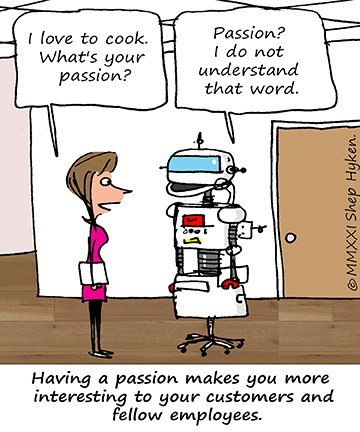 I love seeing visible signs of a customer- and employee-focused culture. My wife and I were on vacation in Mexico. The employees at the resort were amazing. They were upbeat, outgoing and willing to do anything to make their guests’ stay as perfect as it could be. Something I noticed right away was the customer-centric culture that was part of the atmosphere of the resort. You could feel that customer service was at the heart of what they were about.
I love seeing visible signs of a customer- and employee-focused culture. My wife and I were on vacation in Mexico. The employees at the resort were amazing. They were upbeat, outgoing and willing to do anything to make their guests’ stay as perfect as it could be. Something I noticed right away was the customer-centric culture that was part of the atmosphere of the resort. You could feel that customer service was at the heart of what they were about.
In addition to all that one would expect in a resort, there was something that stood out. It was small, yet noticeable. It was the employee name badges. I’ve been to resorts where the name badges included where the team members were from. This extra detail humanized the employees. They weren’t just people working at a resort, but real people from real places. And every once in a while, I’d see that someone was from my state or even my city, which always led to a friendly conversation.
But on this trip, the name badges didn’t state where the team members were from. Instead, they stated their passions. For example, one of our servers had his name at the top of the badge, and underneath it read, “My passion is my family.”
Another team member’s name badge read, “My passion is soccer,” and another, “My passion is fishing.”
What an interesting concept. Including the employees’ passions makes for even better conversation starters that get team members excited about sharing what is important to them with their customers or guests. After all, passion isn’t small talk. It’s big. Case in point, our server was so excited to tell us about his family. Of course, we told him about ours. It created an instant bond between us.
Another employee’s passion was cooking, so we asked what he liked to cook. He shared his favorite meals and how it is as much an event to cook them as it is to eat them. He prepares a weekly feast for his family on Sundays.
This is just a small idea. You’re not going to change a culture by adding an employee’s passion under a name on a badge. You aren’t going to dramatically change the customer experience either. But it does add to the experience, if even in a small way. And small things add up. Before you know it, a number of these small enhancements will make a change to the customer experience. Your customers start to notice. Maybe they notice everything, or maybe just one enhancement. The point is they notice, and that’s good.
Shep Hyken is a customer service expert, keynote speaker, and New York Times, bestselling business author. For information on The Customer Focus customer service training programs, go to www.thecustomerfocus.com. Follow on Twitter: @Hyken
customer service training programs, go to www.thecustomerfocus.com. Follow on Twitter: @Hyken
(Copyright © MMXXI, Shep Hyken)
The post What’s your Passion? appeared first on Shep Hyken.




